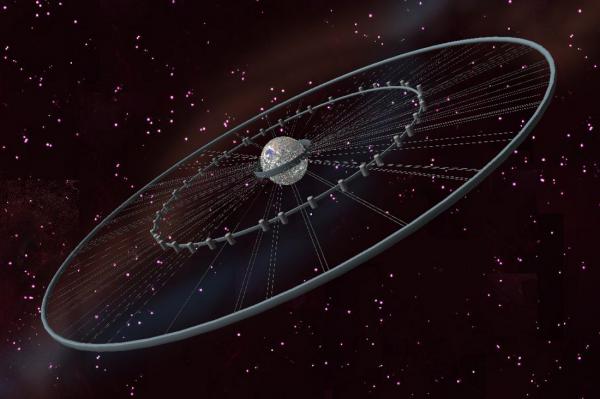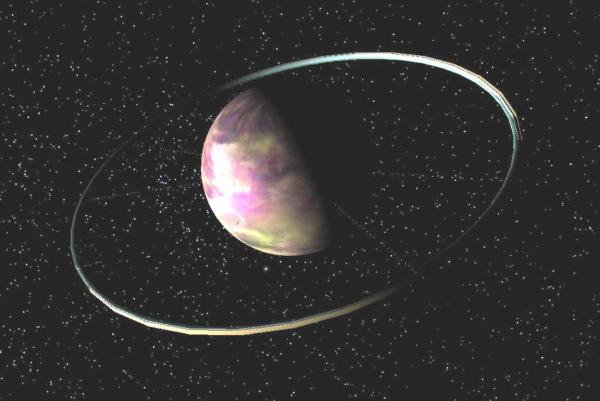BY LETTER
Ribbonworlds
Technology > Technology Type or Material > Drytech/Hylotech
Technology > Technology Levels > High Tech / Hitech
Technology > Application > Infrastructure
Technology > Application > Megascale Engineering
Technology > Technology Levels > High Tech / Hitech
Technology > Application > Infrastructure
Technology > Application > Megascale Engineering
Low acceleration megascale Habitats | |
 Image from Steve Bowers | |
| The outermost ring surrounding the densely-populated world Trip is a low-gravity ribbonworld known as Anchortown. | |
Architects of baseline-friendly spaces rings typically start the design process by assuming the need for acceleration equal to the standard Terran gravity of ~10m/s2 or 1gee and follow up with the question of how big they can make the space ring with the materials available. For your common Bishop Ring, made of diamondoid and buckyfibre cable, this will result in a megastructure up to 2,000 kilometres across. Other designers may assume additional requirements like the need for a rotation period of one day, as in a Banks Orbital, or desire to build a circumstellar megastructure, as in a ringworld. However for these structures a builder would need either godtech materials or unobtanium.
Architects of ribbon worlds don't assume the requirement for 1g, instead ey ask 'what is the minimum acceleration the inhabitants will feel comfortable with?' In the long history of the Terragen Sphere the negative effects of 0g living/working have largely become a thing of the past. Gene-hacks for this problem are numerous, common and easy to install, and many clades are geneered for living full-time in micro-gravity environments. Other problems of using low gravity on a space ring have solutions in technology, for example, the retention of a biosphere can be had through use of a worldroof or airwall. Some level of artificial gravity is often favored over full 0g because a downward acceleration (even a slight one) is a benefit in settling out debris from the air, gives plant life a needed geotropic sense and also makes the hydro-cycle in a large biosphere more predictable. However with the reduced acceleration levels of a ribbon world a vastly larger radius is possible even if made of just diamondoid and buckyfibre cable, 100,000 - 200,000km diameter ribbon worlds are not uncommon and quite a few are larger still. Additionally ribbon worlds can have a slower rotation and many ribbon worlds resemble Banks' orbitals in that they have day long rotational periods and a tilt such that one half of the inside surface is illuminated by the star they orbit.
 Image from Steve Bowers | |
| This low gravity ring habitat surrounding the hydrocarbon-rich world Solaris acts as the counterweight to the many beanstalks extending down to the surface. | |
Ribbon worlds have been built encircling other bodies such as planets. In this case they may rotate slightly faster than the orbital speed for their radius to create the desired micro-gravity accelerations or the ribbon world may be placed on top of a dynamic orbital ring, with gravity coming from the planet below and their biospheres on their outsides. In the later example multiple ribbon worlds may be built up over time to enclose the planet in a supramundane shell. Ribbon worlds have also been built as part of a beanstalk system. A planet with two or more beanstalks can have a ribbon world encircling it that acts as the beanstalks' counter-weight. One example of this is the ribbon world surrounding Solaris depicted in the image above. Such a system may have multiple ribbon worlds, each one at a different height along the beanstalks. A ribbon world may even be built large enough to encircle a star, in fact the belt component of Maximum Air is a ribbon world. But without the integration of other supporting components, as are found in Maximum Air, any circumstellar ribbon world would be a zero gee, or microgravity, environment. Such microgravity ribbon worlds are a special case and to gain full use of their surface area they are fully enclosed in the worldroof, airwall or other that retains their biosphere. The most expansive system ever used for retaining the biosphere of a circumstellar ribbon world is a niven cloud (also known as a smoke ring).
When a ribbon world is combined with a niven cloud it does not rotate within the gas torus to produce artificial gravity, it only orbits within the core. Furthermore such a ribbon world is only 500km wide and less than 5m thick so it generates no local gravity effects through its mass. It is little more than a mat of loosely woven fibres on a belt of bucky cable and acts as a holdfast for the roots of trees and other plant life. These fibres are hydrophilic and collect water from the surrounding air which the plants use. Living in the water are the bacteria and other micro-organisms needed to recycle debris and condition the atmosphere. With a multitude of tiny light sails (from the foglets of the niven cloud) redirecting sunlight in towards the core from all sides the ribbon world can be oriented to the sun in any way. It may be 'flat on' or 'edge on' and have kinks, loops, meanders or twists in it but both sides will still receive the needed light for the growth of a rich biosphere.
Related Articles
Appears in Topics
Development Notes
Text by AI Vin and Steve Bowers
Initially published on 06 February 2006.
Initially published on 06 February 2006.






